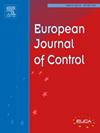非完整移动机器人系统参数函数模糊调谐路径跟踪控制器:实验性能与分析
IF 2.5
3区 计算机科学
Q2 AUTOMATION & CONTROL SYSTEMS
引用次数: 0
摘要
提出了一种基于统一参数输出函数的非完整轮式移动机器人(WMRs)自主导航控制律,通过调整参数实现直线、圆形、椭圆、正方形、矩形及其组合等多种预定路径的自主导航。该方法通过消除为每条路径生成单独的输出函数和相关的独立解耦矩阵的需要,简化了路径跟踪控制范式。考虑了WMR的不确定性,并将其嵌入到控制框架中。通过分析证明,保证了控制律的存在性,并对新框架提出了控制律的存在性,该控制律是用表示各种路径的统一参数函数来表示的。此外,采用模糊规则驱动的增益参数调度框架,有效地实现了控制器的实际实现,避免了执行器饱和。在模拟环境中成功实现预期性能机动后,进行实验验证。利用先锋P3-DX WMR实现通过上述统一函数生成的路径对机动的控制律,这在机器人应用中是相关的。WMR演示了以不同速度(包括零速度)沿着上述路径以更高精度有效导航的能力。零速度特性有助于在中间步骤完成所需的功能,例如拾取物体,从而超越传统的轨迹跟踪方法。最终,基于统一函数的路径跟踪控制框架优于几种现有的控制器,特别是对于在某些部分受到很大曲率的路径,如实验性能和随后的量化所示。本文章由计算机程序翻译,如有差异,请以英文原文为准。
Parametric function based fuzzy tuned path-following controller for nonholonomic mobile robotic systems: Experimental performance and analysis
This research introduces a unified parametric output function based control law for autonomous navigation of nonholonomic Wheeled Mobile Robots (WMRs) through various predefined paths, such as straight line, circular, elliptical, square, rectangular, and their combinations, achieved by adjusting parameters. This approach simplifies path-following control paradigm by eliminating the need for generating separate output functions and relevant independent decoupling matrices for each path. Uncertainties of WMR are considered and embedded within the control framework. Analytical proof is provided to ensure the existence of the control law, which is proposed for the new framework using the unified parametric function that represents various paths, for all time. Further, a fuzzy rule-base driven gain parameter scheduling framework is adopted for efficient real-life implementation of the controller, avoiding actuator saturation. After successfully achieving the desired performance maneuver in a simulated environment, experiments are conducted for validation. A Pioneer P3-DX WMR is utilized to implement the control law towards maneuvering through aforementioned paths generated by the unified function, which is relevant in robotic applications. The WMR demonstrates the ability to navigate effectively with higher accuracy along the aforementioned paths at varying velocities, including zero velocity. The zero velocity feature helps to accomplish the required functionality, such as picking up an object, at an intermediate step, thus surpassing traditional trajectory tracking methods. Eventually, the unified function based path following control framework outperforms several existing controllers, especially for paths that are subjected to substantially large curvature at some portions, as illustrated through experimental performances and subsequent quantification.
求助全文
通过发布文献求助,成功后即可免费获取论文全文。
去求助
来源期刊

European Journal of Control
工程技术-自动化与控制系统
CiteScore
5.80
自引率
5.90%
发文量
131
审稿时长
1 months
期刊介绍:
The European Control Association (EUCA) has among its objectives to promote the development of the discipline. Apart from the European Control Conferences, the European Journal of Control is the Association''s main channel for the dissemination of important contributions in the field.
The aim of the Journal is to publish high quality papers on the theory and practice of control and systems engineering.
The scope of the Journal will be wide and cover all aspects of the discipline including methodologies, techniques and applications.
Research in control and systems engineering is necessary to develop new concepts and tools which enhance our understanding and improve our ability to design and implement high performance control systems. Submitted papers should stress the practical motivations and relevance of their results.
The design and implementation of a successful control system requires the use of a range of techniques:
Modelling
Robustness Analysis
Identification
Optimization
Control Law Design
Numerical analysis
Fault Detection, and so on.
 求助内容:
求助内容: 应助结果提醒方式:
应助结果提醒方式:


